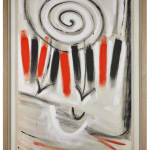Terry Frost 1915-2003
framed: 167 x 115cm
Further images
Sir Terry Frost was one of the foremost abstract painters working in Britain, part of the post-War generation that emerged as a force on the international stage in the 1950s. These artists, which included the likes of Alan Davie, Peter Lanyon, Patrick Heron, William Scott and Roger Hilton, pushed abstraction in Britain in a way that paralleled the Abstract Expressionists in America – such as Rothko, Kline and Pollock, with whom they were in cultural conversation.
From the start of his career in the 1940s through to the 1990s, we see how Frost continuously explored and pushed abstraction, with the later works characterised by their playful and energetic spirit. The present work uses a restricted palette of red, black and white – described as Frost’s ‘primary’ colours. They first appeared while he was living and working in Leeds in 1955 (see Red, Black and White, Leeds, 1955, sold Sotheby’s, 15 November 2011, lot 35, private collection). The combination of colours also references the Russian abstract artists of the early twentieth century, such as El Lissitzky and Kasimir Malevich, whose work was a great influence on Frost. In an interview for his exhibition at the Royal Academy in 2000, Frost said simply ‘black and white and red I think are superb’. Stripping the works back to simplified forms and colour was a means for Frost to explore the inter-relationship between these elements and their emotional impact.






